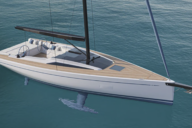 Did you know that if you can read sea bottom chart navigation symbols, this will help you when you anchor or go aground. This skill could even save you lots of money if you choose to clean and paint your bottom–without a haul out!
Did you know that if you can read sea bottom chart navigation symbols, this will help you when you anchor or go aground. This skill could even save you lots of money if you choose to clean and paint your bottom–without a haul out!
Sea bottom abbreviations tell you about the texture, color, and type of material. Navigation charts always show the type of material, such as sand, clay, or oyster shell, but could show texture and color from records gathered hundreds of years ago…
Sailor’s Tale from Long Ago
In the days of the square riggers, sea captains collected and shared depth and seabed information with each other.
A ship that approached an island landfall in thick, pea-soup fog could tell the distance off the reefs with the aid of an armed-lead.
The lead-line was the original depth sounder. Cylindrical in shape with a long marked line–it had a hollowed-out bottom.
The boatswain would smear a coat of tallow in the hollow so that a sample of the bottom would stick to the lead. Then, he was sent as far forward as possible to “cast the lead”.
The lead was cast and the line eased until it became slack upon contact with the bottom. The boatswain read the sounding from the marked line, pulled up the lead, turned it over, and examined the embedded sea-bottom sample.
Was it yellow sand? Or brown sand mixed with bits of shell? Or black mud? He shouted back the sounding, texture, and type of bottom to the Captain. “By the mark 6! With white sand and shells, Cap’n!” This sequence continued, sometimes for hours. From this, the learned captain determined his distance off the “ship-killing” breakers ahead.
Use This Five-Factor Seabed Strategy
Understand the nature of the seabed you sail over to make the best decision when you anchor, go aground, or careen your hull. With this knowledge, you will have the skill and confidence to…
* Choose the best bottom for anchoring * Select the right type of marine anchor * Decide how to anchor in poor bottoms * Locate an ideal spot for careening * Take the right action when grounded
Let’s take a look at each of these five factors, use the seabed table, and determine how to use this in most any small boat cruising situation.
1. Choose the best bottom for anchoring
Which three of these twelve bottom types would be your choice for the safest anchorage for a marine anchor? Sand, hard mud, and clay give your sailboat anchor the best chance of a good, solid set.
Look at the second column at the bottom two abbreviations. Many charts show so or sft; h or hrd–alone, without a bottom type. Locate the closest bottom type within a mile. For example, if you see S within a mile of a hrd abbreviation, there’s a good chance the bottom consists of hard sand. An M would mean hard mud.
2. Select the right type of marine anchor
Most any anchor will hold in protected waters in hard or sticky mud or clay. Cruisers in island anchorages often dive on sand bottoms to make sure the boat anchor buries up to the top of the shank. Lightweight boat anchors–like the Danforth–hold well in most sand, mud, or clay bottoms.
If you have any doubt whatsoever about the quality of the sea bottom (too soft, too hard), amount of swing room, or protection from the elements, use one or more larger plow or claw anchors (the CQR, Delta, or Bruce). Follow this golden rule of anchoring: “When in Doubt, Get the Plow or Claw Out!”
3. Decide how to anchor in poor bottoms
If you must anchor in soft bottoms (sand or mud), grasses, or any of the hard bottoms shown, take extra precautions. Use the heaviest anchor aboard with a trip line (see “Related Articles” below).
Put out a second anchor or send down a sentinel in tight anchorages with less swing room or heavy marine weather. If necessary, rent a mooring for the night.
4. Locate an ideal spot for careening
World cruisers realize the cost benefits of careening the hull for cleaning and painting where haul outs are expensive–or non-existent!
To careen, you must find a bottom that will provide a firm, but soft cushion–such as sand or grass. The tidal range should be large enough to cause the location to dry out at low tide.
Cushion the low side to protect the hull. Scrape, clean, and paint the high side. When the tide comes in, turn the boat around, and repeat the process.
In calm, protected waters you might be able to stand the hull upright. The keel must be strong enough to support the weight of the sailboat hull. Use anchors or timbers to keep the boat straight and the weight distributed.
5. Take the right action when grounded
All of us go aground sometimes–but the initial action you take makes a big difference (see “Related Articles” below). You need to know the type of bottom right away. Mud, sand, and clay aren’t problems for most small cruising boats in protected waters.
But any bottom can turn dangerous in choppy seas, ground swell, or areas with lots of boat wake. If you ground on a hard bottom, determine the type of bottom from the nautical chart or take a bottom sample with a lead line. Next, check for damage below the waterline. If you have a crack or hole, stay put! Repair the damage with a temporary patch before you back off that shoal to prevent flooding.
Courtesy of www.skippertips.com













No Comments